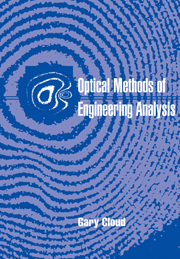Book contents
- Frontmatter
- Contents
- Acknowledgments
- 1 Introduction and orientation
- Part I Optics and interferometry
- Part II Photoelasticity
- Part III Geometrical moire
- Part IV Diffraction theory, optical processing, and moire
- Part V Moire interferometry
- Part VI Holographic interferometry
- Part VII Speckle methods
- 18 Laser speckle and combinations of speckle fields
- 19 Speckle photography
- 20 Speckle correlation interferometry
- 21 Electronic speckle pattern interferometry
- 22 Phase shifting to improve interferometry
- Author index
- Subject index
19 - Speckle photography
Published online by Cambridge University Press: 12 January 2010
- Frontmatter
- Contents
- Acknowledgments
- 1 Introduction and orientation
- Part I Optics and interferometry
- Part II Photoelasticity
- Part III Geometrical moire
- Part IV Diffraction theory, optical processing, and moire
- Part V Moire interferometry
- Part VI Holographic interferometry
- Part VII Speckle methods
- 18 Laser speckle and combinations of speckle fields
- 19 Speckle photography
- 20 Speckle correlation interferometry
- 21 Electronic speckle pattern interferometry
- 22 Phase shifting to improve interferometry
- Author index
- Subject index
Summary
This chapter presents a remarkably simple and effective way to use the speckle effect in the measurement of displacements and deformations. It can give point-by-point or whole-field data, and the sensitivity can be made variable. The method can be extended to use noncoherent illumination, and an example of such an application is described. Certain versions of the technique are closely tied to moire and shearographic techniques. These parallels are noted because they provide valuable unifying insight.
Introduction
A direct and simple exploitation of speckle for engineering measurement is to use it as a microscopic marker of points on the surface of the object being studied. A single speckle is a unique signature derived from the local characteristics of a small area of the object surface and dependent on the geometry of the optical system and the numerical aperture of the illumination or viewing system. If a speckled image is created, then the speckle near a point in the image is uniquely identified with the corresponding point on the object. If the point on the object moves within certain limits, and if the optical system is not changed, then the speckle moves with the point, and the motion is apparent in the image. The speckle is not lost or reformed. If the speckle is recorded for two states of the specimen, then the displacement of the speckle corresponds to the local displacement of the surface.
Suggestions for the direct use of coherent light speckle in displacement metrology and contour mapping first began to appear in about 1968. Subsequent development was quite rapid and somewhat complicated with several different researchers working simultaneously but independently on differing approaches to similar problems.
- Type
- Chapter
- Information
- Optical Methods of Engineering Analysis , pp. 409 - 439Publisher: Cambridge University PressPrint publication year: 1995
- 4
- Cited by

